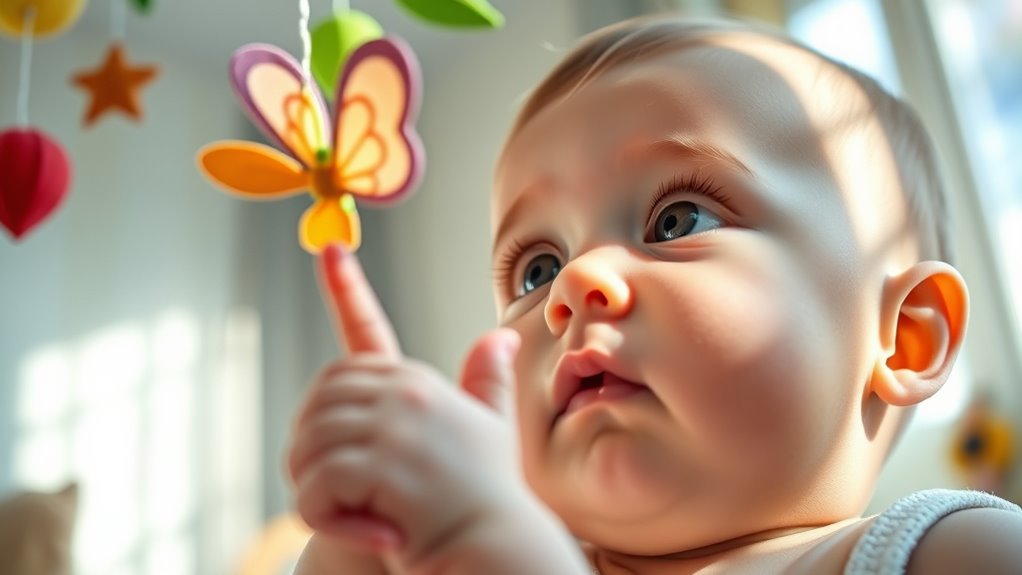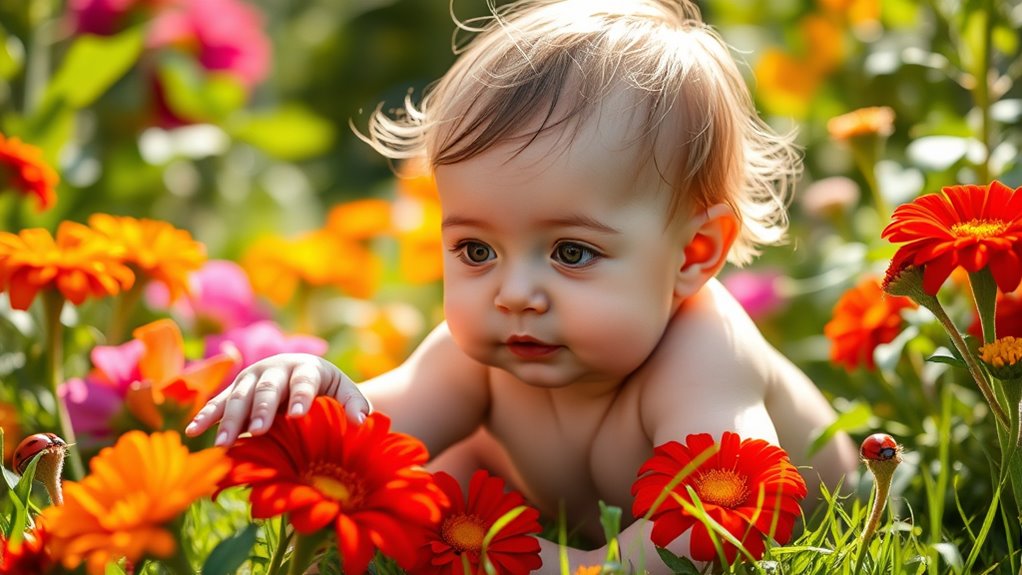Fostering your baby’s curiosity is crucial for their exploration. Engage with their coos and babbles to spark interest in language and communication. Create safe spaces for play, allowing them to discover new textures and sounds confidently. Encourage those “why” questions and respond thoughtfully to nurture their understanding. Outdoor activities and open-ended play materials can boost creativity, too. There’s so much more to learn about supporting your baby’s curiosity and exploration, so keep discovering the possibilities!
Key Takeaways
- Responding to baby coos and babbles strengthens communication and fosters curiosity about their surroundings.
- Create safe spaces with age-appropriate toys to encourage exploration and movement.
- Support toddlers’ curiosity by engaging with their “why” questions and providing thoughtful responses.
- Encourage open-ended play with materials like blocks to stimulate creativity and critical thinking.
- Involve family in shared experiences and discussions to enhance curiosity and confidence in exploration.

As your baby coos and babbles, responding to their sounds not only strengthens your bond but also sparks their curiosity about the world. When you engage with their vocalizations, you encourage them to explore language and communication. Each interaction becomes a delightful exchange, igniting their desire to learn more about their environment. This early interaction is crucial for developing their curiosity and receptive language skills.
To foster curiosity effectively, create safe spaces for exploration. Whether it’s a playmat or a designated area with age-appropriate toys, ensure that your baby can move freely and safely. When they feel secure, they’re more likely to venture out, touch different textures, and discover new sounds. The more they explore, the more they learn about the world around them.
Creating safe spaces for exploration encourages babies to discover textures and sounds, enhancing their learning and curiosity about the world.
As your baby grows into a toddler, encouraging their “why” questions becomes vital. When they ask “why,” it’s a sign of their developing curiosity. Responding thoughtfully to these questions nurtures their desire to understand and investigate. Additionally, engaging in simple experiments or outdoor activities satisfies their curiosity and teaches them problem-solving skills. It’s during these moments of exploration that they begin to see the world as a place filled with possibilities.
Using open-ended materials, like blocks or art supplies, allows them to express their creativity. This type of play fosters imaginative thinking and encourages them to explore concepts without limits. Similarly, unstructured playtime is essential. It gives them the freedom to make choices, develop critical thinking skills, and learn through trial and error.
As your toddler transitions into preschool, continue to nurture their curiosity through artistic expression and nature exploration. Encourage them to express themselves through various mediums, which enhances their creativity. Reading diverse books can also spark their imagination and curiosity. Celebrate their unique ideas, reinforcing their confidence in thinking creatively.
As they enter school age, present them with complex problems that encourage critical thinking. Engage them in open-ended projects that promote innovative solutions. Ask intriguing questions to keep their minds engaged. Balancing creativity with academics enhances their learning experience and encourages independence in problem-solving.
Throughout their journey, remember that family plays a crucial role in fostering curiosity. Shared experiences, discussions about wonders, and support for their natural interests cultivate a lifelong passion for exploration. By allowing unstructured playtime, you help develop their curiosity and confidence, setting the foundation for a lifelong love of learning. Additionally, consider consulting pediatric sleep specialists to support healthy sleep habits that can further enhance your child’s exploration and learning experiences.
Frequently Asked Questions
What Age Does Curiosity Typically Start in Babies?
Curiosity typically starts in babies from birth. You’ll notice them using all their senses to explore their surroundings right away.
Before they hit 12 months, they’ll shake, bang, or throw objects as they figure out what they are. Around 11 months, some babies will stare longer at unexpected events, showing a deeper curiosity.
This early exploration lays the groundwork for their cognitive development and future information-seeking behaviors.
How Can I Safely Encourage My Baby’s Exploration?
Think of your baby as a little explorer, ready to navigate a world full of wonders.
To safely encourage that exploration, babyproof your home by securing furniture and removing hazards.
Create supervised play zones with soft mats and engaging sensory items.
Rotate toys regularly for fresh excitement, and always stay close to guide and support.
Are There Specific Toys That Enhance Curiosity?
Yes, there are specific toys that enhance curiosity!
Look for sensory toys that stimulate your baby’s senses, like rattles with different textures and sounds. High-contrast toys can also capture their attention.
As they grow, consider themed toys, puzzles, and building blocks that encourage exploration and problem-solving. Unstructured playtime allows them to use their imagination.
How Does Curiosity Impact Cognitive Development?
Curiosity significantly impacts cognitive development by driving you to explore and learn.
When you engage with new stimuli, your brain’s reward system activates, releasing dopamine that enhances memory and learning. This process fosters deeper understanding and better recall.
As you satisfy your curiosity, you develop critical thinking skills and a propensity for lifelong learning, which ultimately contributes to your academic success and adaptability in various situations throughout life.
What Signs Indicate My Baby Is Ready to Explore?
Think of your baby as a budding explorer, eyes wide with wonder.
You’ll know they’re ready to explore when they hold their head up steadily, sit with minimal support, and show diminished tongue-thrust reflex.
If they watch you eat intently, reach for food, or open their mouth at mealtime, those are clear signs of readiness.
Keep an eye on their motor skills too; they’ll need those to handle food confidently.
Conclusion
As you watch your baby’s wide eyes light up with wonder, remember that every crinkle of paper and rustle of leaves is an adventure waiting to unfold. Encourage their little hands to explore and their tiny feet to roam, letting curiosity blossom like vibrant flowers in spring. By nurturing their natural inquisitiveness, you’re helping to weave a tapestry of discovery that will shape their world. So, embrace the journey together, and let their imagination take flight.









